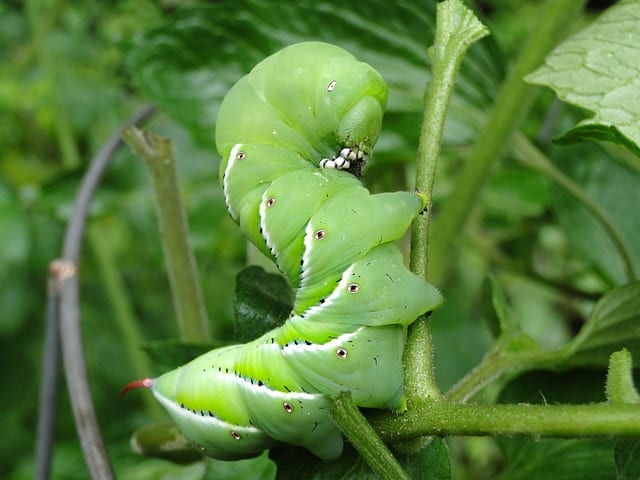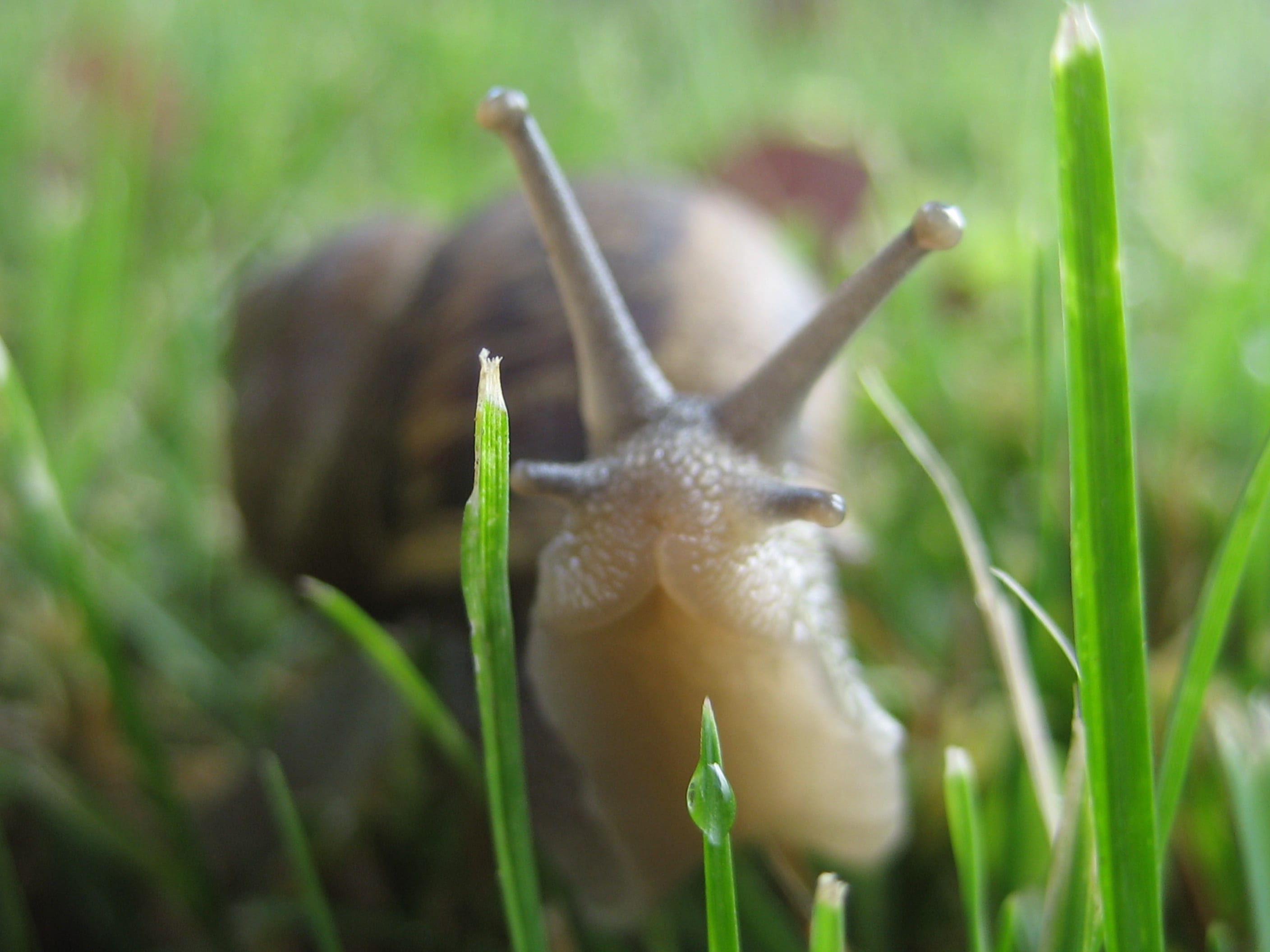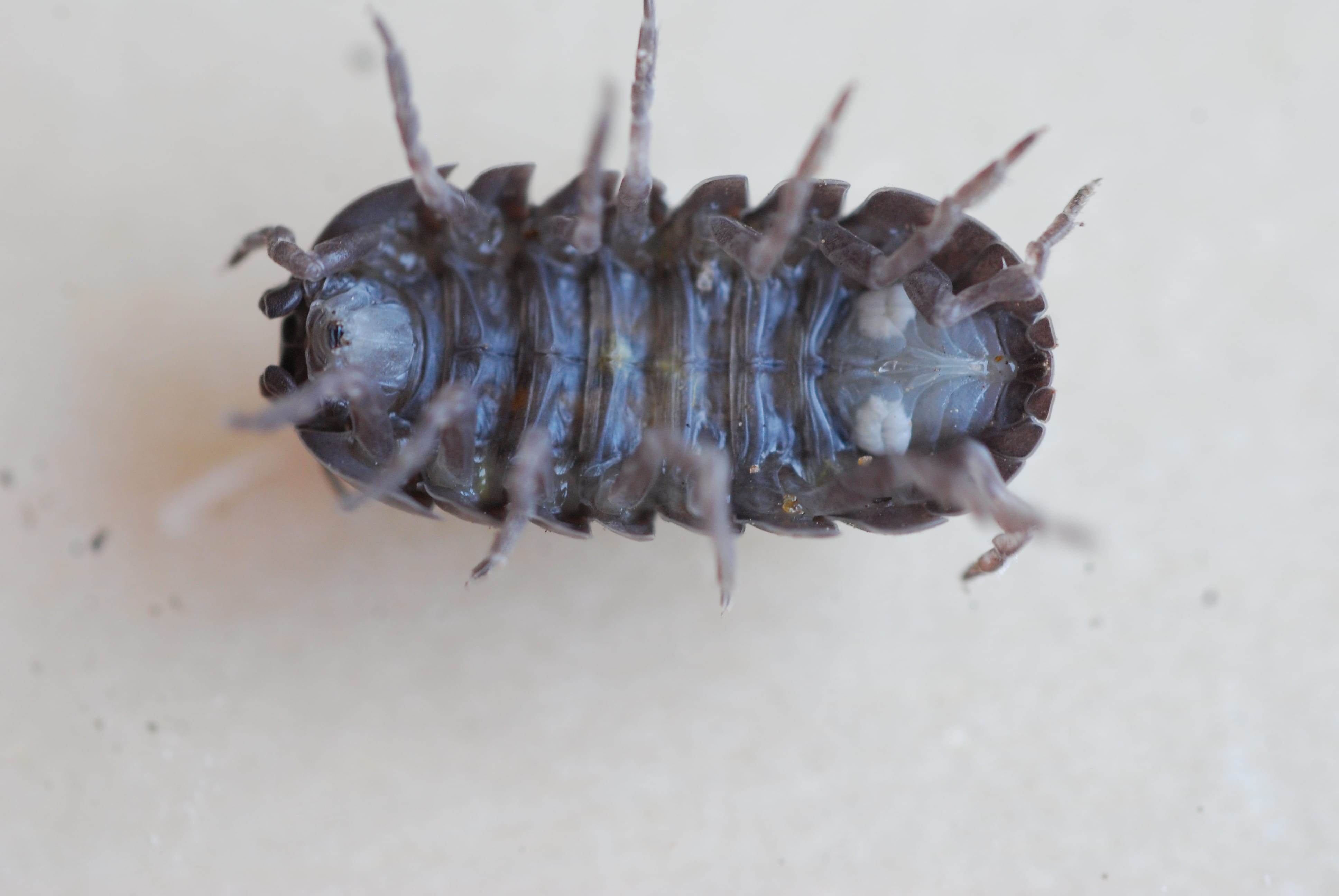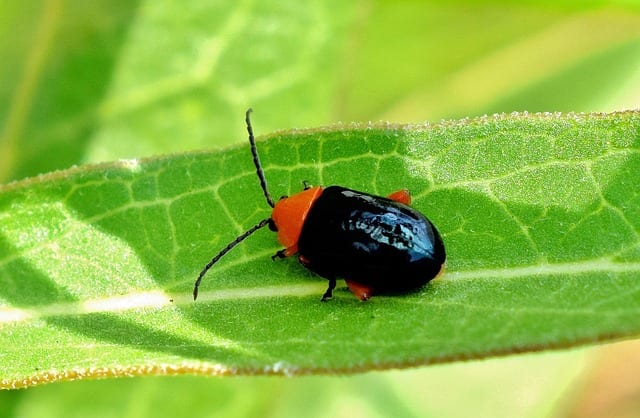You’ll figure out if you have a chewing insects problem by being observant in your garden. Look high, look low, and leave no leaf unturned. Most insects don’t hide in plain sight. You might even have to look for them at night to catch them. Today we’re honing in on the signs and solutions for some common chewing insects.
Some of the main chewing insects we deal with in gardens are: caterpillars, cutworms/hornworms, slugs/snails, sow bugs (pill bugs), and flea beetles.
You usually can tell, just by looking, that chewing insects might be causing a problem. However, the damage can appear in many forms.
- Leaves can look ragged with holes in the center or around the edge.
- Foliage could be stripped and flowers may disappear.
- Leaves look “skeletonized”, or in the case of “borer” insects (like leaf miners) there are tunnel patterns on leaves.
- Plants may be “cut off” at the base of the plant, as though someone took an axe to it overnight.
Caterpillars/Cutworms/Cabbage Loopers
Caterpillars, cutworms, and hornworms are chewing insects that love to chomp on the tender new growth of plants. Caterpillars can quickly ravage your food crops overnight, so at the first sign of caterpillars, take quick action. When I plant veggies, I check on them everyday. I go into battle mode when I see silken webbing on the underside of veggie leaves, tiny, pearlescent-eggs under the leaves, or the culprits trying their best to camouflage themselves against the leaves (they are good at it too). Look for caterpillar frass (black specks of poop) on the leaves of your plants too!

(Tomato Hornmworm, see how easily they blend in?)
Control
- Manually remove and toss to the birds or into a bucket of soapy water.
- Spray with insecticidal soap. Must spray directly on caterpillars to be effective (this means spraying at night sometimes).
- Spray with BT (Bacillus thuringiensis), or Captain Jack’s Spinosad.
- Be sure to check under the leaves where they like to hide out.
(FYI: This blog is about unwanted chewing insects. If you’re worried about killing off a butterfly caterpillar (and this should concern all of us), you should learn what type of caterpillars you have in your garden. Click here to see some common caterpillars in Texas and what they’ll be at maturity. We always advise to start with the least toxic method of pest control first.)
Snails/Slugs
Tender new growth on plants and rain tend to bring out snails and slugs like crazy. Expect these slimeballs to be chomping all night long, although you will also find them grazing during the day when the weather is drizzly and overcast.

Control
- Baits: Products like Sluggo Plus, Bonide Bug & Slug Killer, contain granular baits that you can sprinkle around your plants. The baits attract snail and slugs and they are killed when they ingest them.
- Traps: Beer traps are a fairly cheap way to get rid of these insects. Pour a beer, fresh or stale, halfway up a 6-8 oz. plastic cup and place it on the ground by your plants. The little drunkards will climb in and not be able to get out. Change cups when they’ve been overloaded to keep the lure fresh.
- Diatomaceous Earth can also be used as an organic method for ridding yourself of the slithering duo. The product slices open the exoskeleton of insects when they crawl over it and causes them to dry out.
Sow Bug/ Pill Bug
Instead of an insect, Pill Bugs are actually classified as chewing crustaceans. Sounds like a horrible B-movie title doesn’t it? Coming soon to a garden near you….Attack of the Chewing Crustaceans! When theses insects attack your plants, like vegetables, it is usually because the leaves are directly on the soil. Mulching your plants could help to keep sow and pill bugs at bay.

Control
- Sprinkle Sluggo Plus, Bonide Bug & Slug Killer around the base of your plants.
- Diatomaceous Earth can be applied around base of plants. Remember to reapply after rains.
Flea Beetle
The shiny, blue-black, or brown-black flea beetles are only the size of a pinhead. But you can be on the look out for small, round, irregular spots or holes on your leaves, in the pattern of a shotgun blast. Damage from flea beetles will cause your plants to take on a skeletonized, bleached out appearance before they wilt and die. Young, tender plants are most susceptible and they love to attack your veggies!

(Flea beetles come in many different species. Color variations apply.)
Control
- Spray with Pyrethrin, Captain Jack’s Spinosad, or Neem oil.
- Garlic spray can be used as long as it is when you’ve caught the problem early, and it also must be applied frequently.
- Larger transplants when planting vegetables can also help to avoid the attack of Flea Beetles.
Always read labels of insecticides to provide correct application and to know if a follow up application is necessary.
With everyday observation, you will be able to protect your garden from the damage done by chewing insects. Early detection means less of a battle! Good luck!
~The Happy Gardener, Lisa Mulroy


I have friend who has these black & yellow striped caterpillars eating everything in his yard
Do you know what these are?
Hi Mary Lou,
Did you send a picture? It didn’t come through if so. Can you try again? Or send it through our contact us page? It could be a number of caterpillars, so would need to see it for correct identification. You can also take a look through this identification tool and see if you find it.http://texashighplainsinsects.net/common-caterpillarsCommon Caterpillars/Texas
I had inch worms in my mountain laurel and they destroyed so much of the trees. What can I do to make sure they are gone and won’t come back.
They were probably the Sophora caterpillar. Bt (Bacillus thuringiensis) is effective for killing these caterpillars, but be careful, because it will kill ALL caterpillars, even butterfly caterpillars. Otherwise, plucking them off and squishing them, or sucking them up with a vacuum might work.
I have a pomagranet tree that gets fruit every year but a bug that looks like a stink bug ruins all the fruit. What can I do?
Hi Liz,
You probably have leaf-footed bugs piercing your pomegranates and sucking out the juices. I am going to include a link to our blog about sucking pests so you can see if the leaf-footed bug is what you identify as your pest. It’s best to treat for them before they turn into adults. There is a picture of what the nymphs look like so you can watch out for them. Neem oil is effective at this young stage. Make sure to only spray neem oil in the cool morning or evening hours, not when the sun is blazing.https://www.rainbowgardens.biz/?s=sucking+insects
Something is eating around the edges of my wax leaf Ligustrum. Any ideas?
Most likely the larvae of some type of moth. You can treat your shrub with Bt (Bacillus thuringenienses) This is an organic spray that targets caterpillars, worms.
now something is eating my lemon trees ! the leaves curl & lave a white residue inside. finally saw a critter . he looks kinda like a leaf footed bug but he is green with a red spot on his back. i have neem oil . will that work?
He may be some kind of stink bug, family to the leaf footed bug. You can try the Neem oil. It is a good control product. But stink bugs are difficult to get rid of in adult stage. Spray the Neem all over the plant, underside leaves too. BE SURE TO ONLY SPRAY NEEM IN EARLY MORNING OR LATER EVENING HOURS WHEN THE SUN IS NOT SHINING AND HOT. You could risk burning your plants if not. Also look around your tree. Any debris or weeds around? Remove those to help prevent stinkbugs.
I brought in a plant indoors for the winter and the soil and plant have these tiny , black, slow moving , leaf eating beetles that now seem to be all over the floor . Ant killer on the floor seems to be the only thing that kills them and I see a few everyday on the floor, despite spraying and vaccuming. What can I do ? Please help
These could possibly be flea beetles. But without seeing them, I’m not sure entirely. Spraying the plant with neem oil will most likely take care of the problem. Make sure you spray the plant in the garage, or somewhere it is protected from the sunlight while you spray with Neem. If the beetles are soil-dwelling, a soil drench may be required. this is where you dilute the neem oil with water as per manufacturer instructions and apply the diluted mixture directly to the soil.
I have an avacado plant that I just started growing in a pot.
It seems that some kind if insects are starting to eat the leaves at night.
Any advice I can get to spray it with, or maybe put some kind of net on it ?
Hi Jesse,
Do you happen to have any pics of the damage on the leaves? If it looks like caterpillar damage, Bt (Bacillus thuringiensis) will help eradicate the problem. Be sure to spray in mornings only and spray to cover the foliage (above and under the leaves). However, it is important to properly identify the pest or pest damage before spraying. Do you see any caterpillar frass (little black balls…caterpillar poop) on the leaves of your avocado tree or around the pot? Look at the descriptions in the post and see if the damage matches up to any of these pests. Hope this helps.
I have always used nematodes for organic control of fleas, but last year had to resort to a non- organic grub control so now can not do nematodes. What would you suggest for grub and flea control that is safe for my dogs. The dogs are on Nexguard too.
Hi Alice,
Of course nematodes are our best answer for safe pest control around pets. Many grub control products could be harmful for pets to ingest, inhale, etc… HOWEVER…many products will state that once the product has been applied, watered in thoroughly, and dried, they can be safe for pets to reenter the space.
We generally can’t take a stance on what product will be safe for you pet, as some pets are more prone to dig, eat plants or grass, etc…. I would take a good look at all product information labels and then contact your vet to discuss if you are concerned about the possibility of contact with your dogs.
What do you recommend to get rid of the red mountain laurel mirid. They are really damaging my mountain laurels! ☹️
Hi Elaine,
These are quite a pain, but the good news is that they are only around from early to late spring…which we are coming up on. They are members of “true bugs” which pierce leaves and suck the juices. They will distort the foliage for a little while and then be gone, and new foliage should replace the damaged. They are difficult to get rid of, and spending a lot of money on product isn’t recommended. However, you can try shooting them away with hard blasts of water from the hose, or you could try a pyrethrin type of spray on an end hose sprayer if you really want to try a product. Hang in there, they’ll be gone soon.
Why my gardenia leaves turning yellow?
Hi Maria,
Without knowing for sure how your gardenia is being taken care of, how it is is planted, etc… I can’t say for sure, but I will give you some reasons that are common for gardenia leaves turning yellow. Underwatering or overwatering are usually a big culprit. With the heavy rains we recently received, this could be the reason. Is your gardenia planted where there is sufficient drainage? If planted in a container, the container should have adequate drainage holes. If planted in the ground, soil should have been amended (cotton burr compost, peat moss, to acidify) properly to allow for good water drainage. What kind of light is your gardenia getting? Morning light and shade in the hottest of afternoon sun is ideal (too much or too little light can also turn leaves yellow). Iron deficiency is also a possibility when soil has been leached of nutrients, so think about what type of soil it is planted in and how healthy it is. Hope this helps some.
The gardenia is in the ground and The sun all afternoon
For our type of sunlight in San Antonio, I’d suggest finding a spot where your gardenia gets some reprieve from the hottest of the afternoon sun. It tends to be too harsh here in our city. Again, it could be from the heavy rains we just received. It could also be a lack of acidity in the soil so you’ll have to think about what you did to amend the soil before planting. Scale insects can cause yellowing that presents at first with yellow spots on the tops of the leaves. If you can send a picture in to us, or bring in a couple of leaves for us to diagnose, that would be best.
Hi please need some help my hydrangea leaves very pale yellow almost white and some of the edges look brown what do I need to do ? It’s in a big pot
Hi Marie,
More info is needed to diagnose. How often do you water, what type of sun exposure does your hydrangea get, and does your pot have a drainage hole. We’ve had a lot of rain, so it could be due to overwater issues especially if pot does not drain well, or iron chlorosis because of the extra rain we’ve had recently. What have you been feeding your hyrdragea and how often?
The Pot has good drainage and it’s daytime sun I water every other day sometimes every day if it’s too hot and we don’t have any rain I feed it organic manure Coffee left over egg shells and pink hydrangeas food One’s
Hi Marie,
The washed out color of the foliage could be iron chlorosis brought on by the amount of rain we have been receiving with a combination of too much sun in the afternoon. For hydrangeas in San Antonio, any sun after 11AM is too much. Move your pot to an area that gets only morning sun and afternoon shade and offer it a chelated iron product or ammonium sulfate and give it some time to recover.